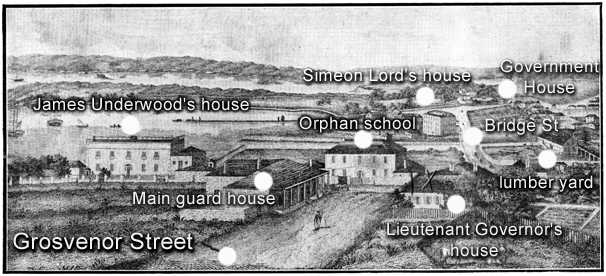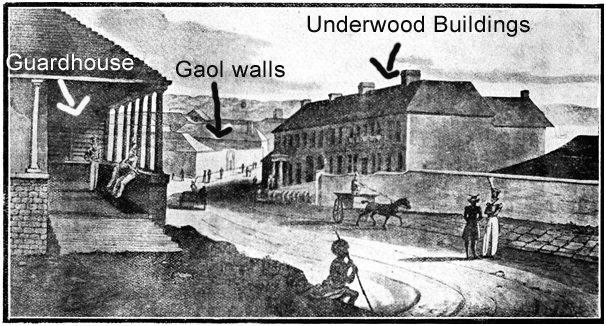It would require a man of strong imagination today to stand in Grosvenor street, look across George street towards Pitt street, and imagine, first, a fine, large house, and behind it, stretching to Pitt street, and embracing an area of ground one and half acres in extent, a magnificent ‘garden of flowers and fruit trees—a garden that had cost £300 to create. Yet that is the sight that would have met the eye of a man standing there in the year 1800.
The “fine brick mansion,” as it was referred to and the garden were owned by Lieutenant Kent, but in the year named they were purchased by Governor King for the sum of £1539/17/3, and converted into an orphanage. The house continued as an orphan school until about 1828 when the land was sold for £5200 after Queen’s place (now Dailey street) had been driven through it.

SYDNEY, FROM ST. PHILLIP’S CHURCH IN 1813.
The street in the foreground is Grosvenor street. At right angles to it runs George street. The building on the left with flat roof is the house of James Underwood. To the right of that, in Grosvenor street, the verandahed building is the main guard house. On the opposite side of the street are the house and garden of the Lieutenant-Governor. The white building in the centre with five windows in the top row is the Orphan School. The street to the right of Grosvenor street, leading up the opposite hill, is Bridge street. The land in that street enclosed by a white fence (seen over the top of the Lieutenant-Governor’s house) is the Lumber Yard. The large building on the left of Bridge street is Simeon Lord’s house, and beyond it at the top of Bridge street is Government House.
George Thornton
Down this latter street is a quaint nest of cottages-12 on an area 91 by 78feet—known as Queen’s court, in one of which Henry Parkes lived for a time. Now let us look at the other side of the street, retracing our steps to Essex street.
On the southern corner of this street lived an innkeeper, Samuel Thornton, who had a son, George. The Hon. (as he afterward became) George Thornton used to relate how he had a hand in the birth of the “Sydney Morning Herald.” It appears that on the night of April 18, 1831, when the first number of the “Sydney Herald” was printed, the proprietors sent over to Mr. Thornton’s for some candles, and young George went over and held the candles while the formes were made up.
Almost half the area between Essex street, from which it started, and Grosvenor street was a grant to W. C. Wentworth. This grant had a frontage of 200 feet to George street, and when the land was sold in June, 1830, it realised an average of £35 per foot “the highest price that has yet been obtained for any description of building ground in this colony,” as the “Sydney Gazette” informs us.
A little past the Wentworth grant was at one time the office of the “Sydney Morning Herald,” and in 1828 adjoining that site stood for some time a half-finished building which the speculator had intended to be Sydney’s great theatre; but promise fell short of achievement. Next this was the office of the “Sydney Gazette,” where that paper gave up the ghost a ghost that would be in a wonderful and fearful company of departed Australian newspaper spectres when it crossed the inky Styx.
Main Guardhouse
On the north corner of George and Grosvenor Streets stood, at least as early as 1813, the main guardhouse. We are apt to forget that up to the 1820’s Sydney was more or less an armed camp, the foe being represented by gangs of convicts, which were to be overawed by exhibitions of armed strength. To this end, we had guardhouses and sentinels in various parts of the city. This guardhouse remained until one Easter Sunday when a very heavy fall of rain washed the main part of the building into George street.

GEORGE STREET, LOOKING NORTH PROM GROSVENOR STREET, IN DECEMBER, 1826.
On the left is the main guard-house. The white wall further down the street is the front wall of the gaol on the corner of Essex street. The buildings on the right stand on the giant of James Underwood, and were known as “Underwood’s buildings.”
John Hordern
On the corner stood for a number of years the Berlin Wool shop of John Hordern, son of the original Anthony and father of Hordern Bros., of Pitt Street. In the days when our grandmothers wove wonderful wool ornaments the art of which lay in perfect matching and blending of shades, Mr. Hordern’s shop was the mecca of the fair sex.
Parade Ground
I have related one incident which startled Sydney, and the spot we have now arrived at—the intersection of Grosvenor street with George street—brings to remembrance another incident in a still earlier Sydney that was the sensation of the hour.
The year was 1801; and if readers will go a little way up the Grosvenor street hill with me we shall turn round and view the scene as it appeared in that year of grace. Behind us the walls of St. Phillip’s Church are rising; close by, on the left, is the house of the Provost-Marshal (the sheriff of the day) ; next that, and extending in a diagonal line to George street, are two large storehouses; on the right-hand side is the garden, and on the George Street frontage, the house of the Lieutenant-Governor.
A little to the left of the house is a sentry box containing the Lieutenant-Governor’s own particular sentry. On the other side of George street rises the Orphan School. The storm waters rushing down the hill have worn a channel, and to the left of the orphan school is a bridge over the channel.
Through the diagonal course of the storehouses the area before us is much larger than it was when the picture was drawn. This open space is the parade ground, and hither every morning came the regiment on parade.
Sydney Hotel
Dr. Johnson, with the memory of countless nights spent at the Mitre and the Crown and Anchor, once remarked that “a tavern chair was the throne of human felicity.” If we had possessed a Johnson in Sydney in the ‘twenties there would have been many references in his indispensable Boswell to the Sydney Hotel, the site of which is the southern corner of George and Grosvenor streets. Great steel latticing is pushing its way to the skies at this moment on the spot as the framing for the new offices of the Union Steamship Company. The site, however, has round it far more interesting associations than that of a well-known tavern. In fact, to begin at the beginning of its history, we must go back to the First Fleet and 1788. With Governor Phillip there came, as Lieutenant-Governor, Major Ross, and that gentleman selected this spot as the site of his house. If one could push on one side the buildings in front of it one could see what excellent taste the major displayed.At our feet would be the waters of the Cove, and from these we could lift our eyes to behold the glorious length of the Harbour to the Heads. The building was started in April, 1788, and Collins, in referring to it, says: “One face of which was to be in the principal street of the intended town.” This entry is interesting, for it marks for us where Phillip’s noble street of 200 feet width was to run.
